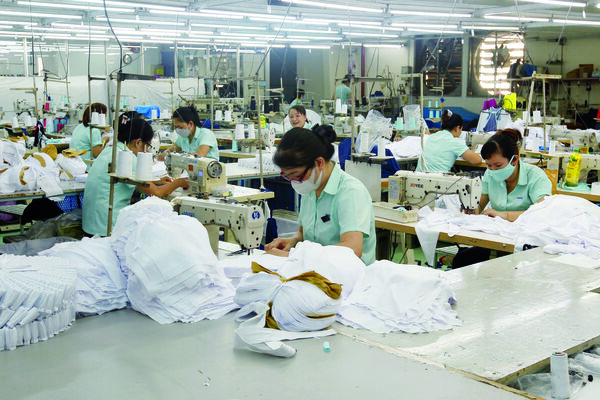>> The service and industrial sectors will need the most recruitment
>> Improve the quality of Vietnamese workforce overseas
>> The National Assembly looks at the work of the staff
>> Need for a human resource management mechanism
| Workers of Sarl Ampfield, located in the industrial zone of Tân Binh, in Ho Chi Minh City. |
| Photo : VNA/CVN |
After suffering the effects of the pandemic for two years, job opportunities in the Southeast have become scarce. At the end of 2022 – beginning of 2023, many workers in this region had their jobs suspended or their employment contracts terminated due to the lack of activities of their companies. This situation has left them without a source of income, making their lives precarious, especially for older and poor workers.
Precarious life of workers
VT Thoa, a former employee of Sarl PouYuen Vietnam, located in Bình Chánh district in Ho Chi Minh City, has been looking for a new job since the termination of her contract. Her husband is a driver and does not have a stable job. It is a burden for them to bring up their four school-aged children. “Our life is getting harder and harder. Fortunately, our children are studious. In addition, we regularly receive aid from local authorities and various organizations and communities”she shares.
LM Ngoc, who worked for Sarl Ty Hung, located in the district of Binh Tân in Ho Chi Minh City, also lost his job because his company had no more orders and had to reduce its production activities. Like many of his colleagues, Ngoc cannot hide his sadness and concern at the lack of job opportunities and has a strong fear of unemployment. “I’m really worried about the future and don’t know what to do or where to go”she laments.
Two years after the outbreak of COVID-19, although the difficulties seemed to have been overcome, everything is really unpredictable and difficult for companies and employees, especially for export-dependent sectors. Faced with this situation, many workers from outside the city are forced to send their children to the countryside to live with their grandparents. Some have even returned to their places of origin.
After the departure of her husband and their two children for their native village in the province of Thua Thiên Huê (Center), HT Trang, worker of Sarl Ampfield, in the industrial zone of Tân Binh in Ho Chi Minh City, remains reluctant to leave, even though orders fell sharply. She is one of the remaining 78 workers who are facing many difficulties as their company continues to plan to reduce working hours. “Despite the small number of orders, we are lucky compared to our 700 colleagues. Some companies have been forced to go out of business”, she expresses.
Cu Phát Nghiêp is president of the Sarl PouYuen Vietnam union in Ho Chi Minh City, which sometimes had more than 50,000 employees. He says that when the pandemic broke out, thousands of workers, worried about its unpredictability and their livelihoods in the city, rushed to their hometowns. “Once the epidemic was under control, the company accelerated its recruitment to catch up on the backlog. However, activity has still not returned to its pre-crisis level, and therefore the hiring of new workers has been temporarily suspended”he informs.
Apart from Ho Chi Minh City, many cities and provinces, especially those in the Southeast, find themselves in this critical situation. According to the General Statistics Office, on 1is quarter of 2023, the country had 294,000 workers in technical or partial unemployment, a decrease of 2,000 compared to the 4e quarter of 2022, mainly in companies with foreign capital (83.3%), including 36,400 in Binh Duong, 35,000 in Dông Nai, 21,800 in Tây Ninh and 19,800 in Ho Chi Minh City.
 |
| Job fair recently organized by Ho Chi Minh City Youth Employment Service Center. |
| Photo : VNA/CVN |
The Southeast is the most dynamic region of the country, with hundreds of industrial and free zones as well as many large domestic and foreign companies, attracting millions of workers from all over the country. However, many localities are confused by an increasingly unstable job market.
For example, in the face of the complicated development of the COVID-19 pandemic in Ho Chi Minh City and the southeast provinces, millions of laborers have flocked to their hometowns en masse. This great exodus of labor caught state management bodies, local authorities and companies by surprise, who were unable to take precautions in time. This had a negative impact on production and trade activities.
United to overcome difficulties
Pham Chi Tâm, vice-president of the Ho Chi Minh City Labor Confederation, believes that although everything has an unforeseen effect, the situation of workers forced to quit their jobs, especially before and after the Tet holiday (New Year moon) of 2023, creates great pressure on families and society as a whole.
Faced with this situation, the Confederation of Labor of the Southern Megacity has asked the unions of companies to connect regularly with employees and employers to find timely solutions to overcome the difficulties.
The trade union organizations thus reinforce the dialogue with the workers and organize, in collaboration with the competent bodies, job fairs. They also cooperate with local authorities to closely monitor the labor situation and the difficulties of companies, and support workers in difficult situations.
Nguyên Van Lâm, deputy director of Ho Chi Minh City’s Labour, War Invalids and Social Affairs Department, says that it implements labor relations, social security and insurance policies -unemployment to help employees cover salary costs and stabilize their lives after losing their jobs.
Placement centers and vocational schools are increasing their training, advice, resources and new offers to support workers in need.
For its part, the Municipal People’s Committee helps those in the informal sector to access loans from the National Employment Fund, the Poverty Reduction Fund and microfinance institutions.
Huong Linh/CVN
2023-05-26 23:47:31
#Labor #market #instability


